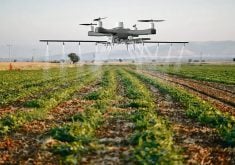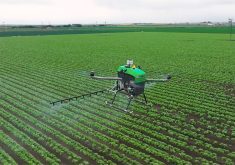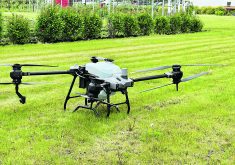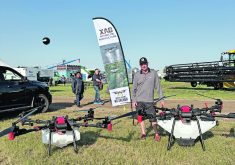Drones are gaining ground in the field, mapping crops and pinpointing problem areas, enabling speedier response
Drones are becoming an increasingly popular and important tool for farmers as the unmanned aircrafts become more flyable and affordable.
Until recently, only a handful of growers and companies offering crop imagery services made regular use of drones for business, but farmers and agronomists entering the industry today are finding drones to be a common tool.
At the Ag In Motion grounds near Langham, Sask., an Ag Drone Flight school was held at the end of October.
Markus Weber of LandView Drones told those in attendance that agricultural drones are primarily used in two ways.
Read Also

Farming Smarter receives financial boost from Alberta government for potato research
Farming Smarter near Lethbridge got a boost to its research equipment, thanks to the Alberta government’s increase in funding for research associations.
“One is map some area with NDVI (normalized difference vegetation index) and by doing that, figure out where there is a problem and then go ground-truth it and figure out what’s wrong.
“Or once you’ve already established there is something is wrong, like a spray drift issue or a pest issue, you can document how big it is, or even documenting things like a hail event.”
Many of the 23 attendees at the flight school were young farmers and agronomists who intend to use drones in their business.
“I’m working with my dad to get it on the farm. He thinks it’s cool but he has no idea what is going on with them, which is why I’m kind of taking over,” said Shelby LaRose, who recently graduated with a bachelor of science in agriculture and works on the family farm near Kipling, Sask.
The LaRose family plans to use a drone to scout difficult to access areas.
“A lot of our land is in the bottom of a marsh and in summers it can get quite wet. So we are also looking at getting into some of those areas where we can’t drive, in order to see what the water situation is in the field, and how crops are doing in those areas,” LaRose said.
She said they also intend to use the drone to help make drainage plans on some fields.
Growers with thousands of acres to scout in limited time windows often hire agronomists to help them stay on top of crop needs.
However, agronomists are limited in how far they can drive and walk in a day and timing can be critical with crop health issues.
Dustin Brons also attended the drone flight school. As an agronomist for the Lake Lenore Co-operative Association, his primary function in summer is scouting crops.
“You can get a better idea of where the crop is weaker and where it is stronger. It’s mainly just as a tool to make my crop scouting more effective, especially when the crops are bigger,” Brons said.
“Once it’s waist high, instead of walking, it will be much quicker to fly over top of it. Not to say you don’t need to walk the crop at times, but it will give you a better idea of where you need to go.”
Brendon Friesen, an agronomist at Point Forward Solutions in Camrose, Alta., said he plans to offer drone imagery services to his customers.
He thinks drones are becoming so easy to use and affordable that each producer should buy their own base-level drone with a RGB camera because the cost of professional crop scouting with a drone will be higher than many growers will want to pay.
“It’s cheaper to get the producer to do the imagery collection themselves, then either make the decision themselves or send it to an agronomist to help them make that decision,” Friesen said.
Even if growers use drones only for crop scouting, they can still provide significant return on investment by saving time at a critical time of year.
“It’s going to just give them that aerial view to help identify problem spots, so you can identify where you need the boots on the ground to figure out what the problem is,” Friesen said.
For growers who want a drone with a RGB camera robust enough to employ for agriculture applications, Friesen recommends the basic package of the DJI Inspire 1 drone, or the new DGI Mavic drone, which is a small, yet effective quad copter.
LaRose has decided to get the Inspire 1 drone at what is called the “prosumer” package level, which includes NDVI sensors.
“That is why we are going with the Inspire system, because you can get a NDVI camera attachment for it,” LaRose said. “My primarily use isn’t just going to be taking pictures and stuff, which is also very cool. I want it for the NDVI.”
There are two main approaches in flying drones. One uses an assisted flight mode, in which if the operator does nothing, the drone will hover in place with the assistance of GPS.
“The other mode we can fly in is semi-autonomous mapping. You can tell the aircraft that you want to map a certain area. Most multicopters will be in the 80-acre range in one flight. You outline the area you want flown and it will take off and land by itself and fly a path back and forth … taking pictures and create one big map of that field,” Webber said.
Today, growers can use drone images to spot symptoms of crop health issues, but these images won’t tell you the reason for these problem.
“If you have cutworms, you’re going to see cutworm spots where you have some cutworm damage. But it won’t tell you that it’s a cutworm problem until you go there.”
However, with new sensors being developed, drones may soon be able to tell farmers what the problem is, not just show them that there is a problem.
Webber expects to see major developments in drone sensors because of the increasing use of artificial intelligence in their development.
“We’ve been looking at spectral signatures of plants for several decades and there is a lot of academic research on that front, but it hasn’t been applied to this type of technology,” Webber said.
Soon, with the use of different spectral sensors, growers will be able to clearly see what the problems are on their fields.
“You will be able to pick out what the different weed species are in your field, or exactly which disease is out there. We are only years away from that being possible,” Webber said.
LandView Drones, working with BlackHawk Aeronautical Solutions, offers Ag Drone Flight Schools in Alberta and is planning to hold another Saskatchewan school in April.


















